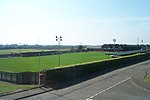Central Park, Cowdenbeath
1917 establishments in ScotlandCowdenbeath F.C.Defunct greyhound racing venues in the United KingdomFootball venues in ScotlandGreyhound racing in Scotland ... and 6 more
Motorsport venues in ScotlandScottish Football League venuesScottish Professional Football League venuesSports venues completed in 1917Sports venues in FifeStock car racing venues

Central Park is a multi-use stadium in Cowdenbeath, Fife, Scotland, used for football and stock car racing. It is situated in the centre of the town, just off the High Street, and has a capacity of 4,309. The pitch size is 107 x 66 yards. Central Park has been the home ground of Lowland League team Cowdenbeath F.C. since it opened in 1917. Stock car racing has taken place at the ground since 1970, and takes place on a tarmac racetrack surrounding the football pitch. Central Park was also previously a venue for greyhound racing between 1928 and 1965.
Excerpt from the Wikipedia article Central Park, Cowdenbeath (License: CC BY-SA 3.0, Authors, Images).Central Park, Cowdenbeath
Chapel Street,
Geographical coordinates (GPS) Address External links Nearby Places Show on map
Geographical coordinates (GPS)
| Latitude | Longitude |
|---|---|
| N 56.108738888889 ° | E -3.3470972222222 ° |
Address
Central Park
Chapel Street
KY4 9QQ
Scotland, United Kingdom
Open on Google Maps







